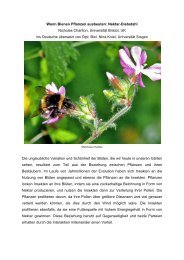PhDâ€theses - Ethologische Gesellschaft
PhDâ€theses - Ethologische Gesellschaft
PhDâ€theses - Ethologische Gesellschaft
You also want an ePaper? Increase the reach of your titles
YUMPU automatically turns print PDFs into web optimized ePapers that Google loves.
Research Update<br />
THE IMPACT OF SOCIAL RANK AFTER CONFRONTATION WITH CONSPECIFICS ON THE<br />
REPRODUCTIVE COMPETENCE OF MALE DJUNGARIAN HAMSTERS (PHODOPUS SUNGORUS,<br />
PALLAS 1773)<br />
Anna Müller<br />
anna_mueller@gmx.net<br />
Diploma Thesis, Supervisors: Dr. Peter Fritzsche, PD Dr. Dietmar Weinert, Institute of<br />
Biology/Zoology, University of Halle<br />
Dominance is a central feature of agonistic behaviour across a wide range of taxonomic<br />
groups and important in order to occupy new limited territories, resources or to increase the<br />
access to mates within a social group with a hierarchical background. In laboratory analyses,<br />
hamsters seem to be excellent model organisms for studying fundamentally functional and<br />
mechanistic characteristics of aggression processes. Several researchers described high‐<br />
aggressive fights between male Djungarian hamsters (Phodopus sungorus) sometimes<br />
resulting in death of one individual of the encounter pairs. But relatively little is known<br />
about the social behaviour of these animals. Therefore males of Phodopus sungorus were<br />
used in this study to analyse dominance/subordination‐relationships and their possible<br />
impact on fertility and reproductive success. Males were confronted as dyadic encounters in<br />
a neutral arena and in their housing cages to define agonistic and submissive behavioural<br />
patterns as well as to characterize them by means of morphological and physiological<br />
parameters. Furthermore, it was investigated whether females choose males depending on<br />
their social status.<br />
Specific dyadic encounter‐experiments showed that the males were able to form<br />
stable dominance/subordination‐relationships under laboratory conditions and could be<br />
classified into dominant and subordinate individuals by characteristic agonistic and<br />
submissive behavioural patterns. A comparison of dominant, subordinate and singly caged<br />
individuals revealed significant larger and heavier testis and a higher number and density of<br />
sperms in dominant males. Whereas no differences in plasma testosterone could be found,<br />
subordinate males had higher corticosterone levels in their faeces. Finally, females of<br />
P. sungorus in the oestrus phase preferred dominant males compared to the other phases of<br />
the sexual cycle.<br />
17



